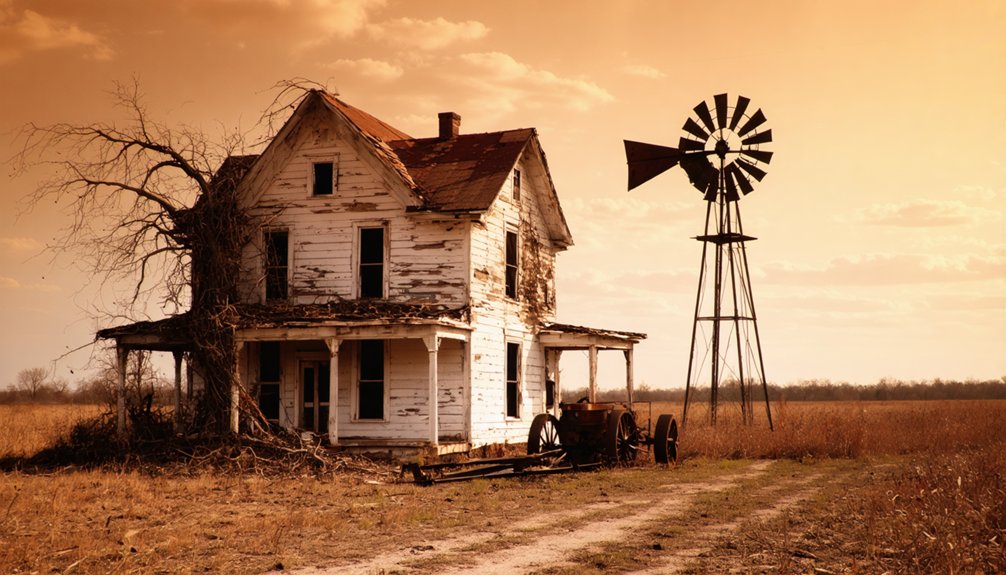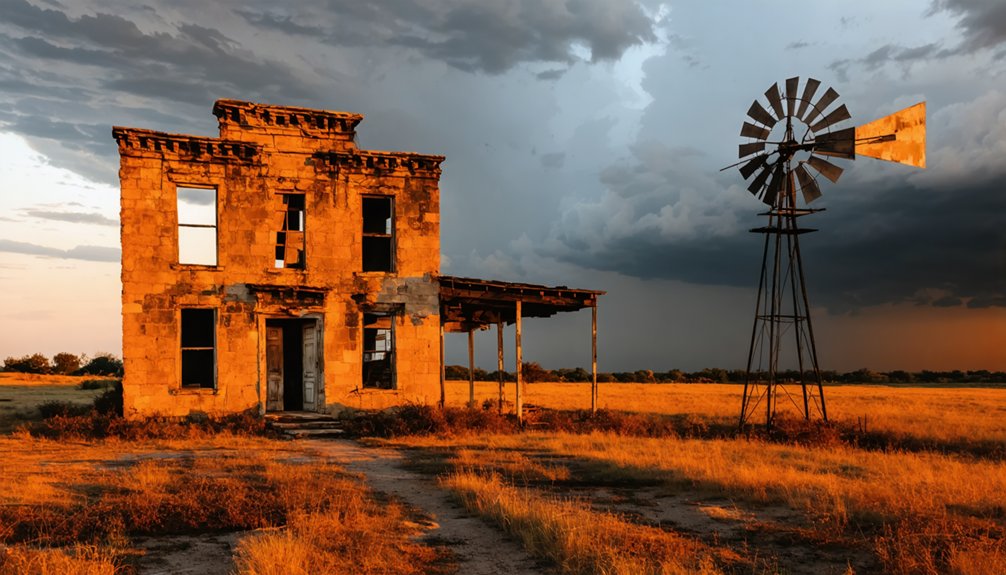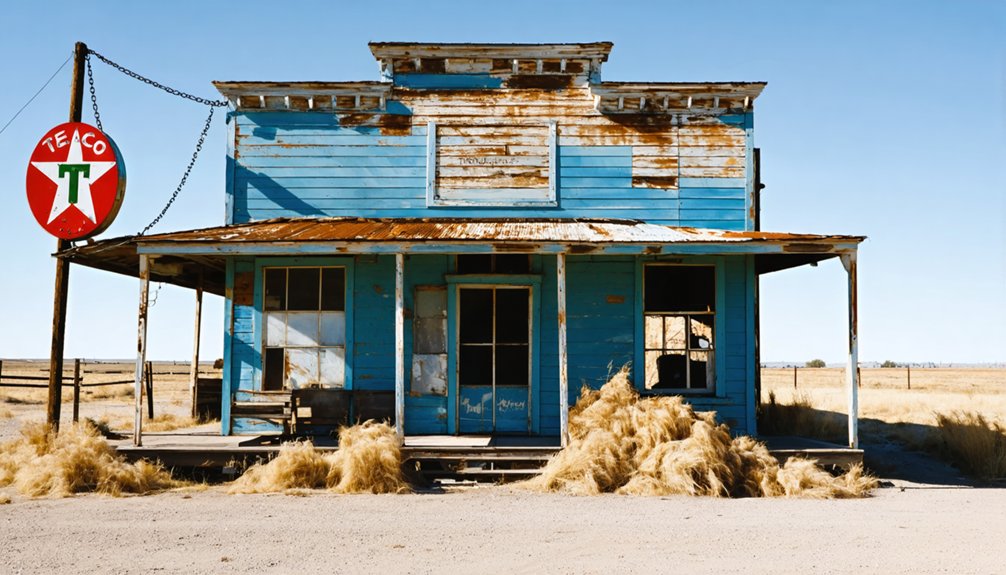You’ll find Tennyson, Texas in Coke County, where Samuel Sayner’s 1882 vision for a farming community first took root. The town grew from humble beginnings with a post office established in 1894, named after poet Alfred Lord Tennyson. Despite reaching around 100 residents by 1890, economic hardships and devastating fires led to its abandonment by 1953. Today, sandy soil and scattered ruins tell the story of this West Texas settlement’s rise and fall.
Key Takeaways
- Tennyson was established in 1882 by English immigrant Samuel Sayner, who named the settlement after poet Alfred Lord Tennyson.
- The town peaked with around 100 residents in 1890, centered around farming, ranching, and essential services like a post office.
- Economic hardships, fires, and changing transportation routes led to the town’s decline, with most residents leaving by 1953.
- Current remains include scattered foundations and weathered stone chimneys in Coke County, Texas.
- Visitors require high-clearance vehicles and should prepare for desert conditions when exploring the remote ghost town site.
Origins and Early Settlement
While many Texas Panhandle settlements emerged during the late 19th century’s westward expansion, Tennyson took root in the rolling prairie landscape where early pioneers found promise in the semi-arid plains.
Much like early river crossings that helped establish frontier towns, these settlers recognized the vital importance of accessible water sources.
You’ll find that settler motivations centered on the land’s potential for ranching and farming, with families choosing sites near crucial water sources and travel routes.
These hardy folks built their first homes from local materials like wood and sod, spacing their homesteads widely to accommodate open-range agricultural practices.
Early settlers crafted dwellings from the land itself, building far apart to embrace the vast open spaces needed for farming.
As more settlers arrived, you’d have seen a small but determined community form around essential services – a post office, general store, and schoolhouse.
Despite geographic isolation making access to markets challenging, these pioneers forged ahead, establishing a frontier outpost that embodied the independent spirit of the Texas Panhandle.
The community thrived on cotton farming until devastating boll weevil infestations in the early 1900s caused massive crop losses.
The Vision of Samuel Sayner
After immigrating from Bubwith, England, Samuel Sayner forged his vision for Tennyson in 1882 when he purchased land near Mule Creek in southeastern Coke County.
You’ll find that Sayner’s vision went beyond mere ranching ambitions – he aimed to build a lasting community in the untamed West Texas landscape.
The town would eventually support several small businesses in its early years.
He established the post office in Tennyson, naming the town after the renowned English poet Alfred Lord Tennyson.
Life in Early Tennyson

Despite its humble beginnings, life in early Tennyson centered around farming and ranching, with about 20 pioneering residents establishing homesteads in the 1880s and 1890s.
Your daily routines would’ve revolved around working the land, tending livestock, and helping neighbors with communal tasks like barn-raising and harvesting.
You’d have faced significant community challenges, including limited access to markets, harsh weather, and isolation.
The post office, opened in 1894, became your essential link to the outside world.
While you’d find basic services at the general store and blacksmith shop, you’d need to rely heavily on self-sufficiency and mutual aid.
Living in wooden frame houses typical of frontier settlements, you’d gather with fellow residents for informal social events, sharing resources and working together to overcome the hardships of frontier life.
Like many of the 511 ghost towns across Texas, Tennyson’s population gradually declined as economic opportunities shifted elsewhere.
The town, like nearby Bartonsite, eventually became a barren site as residents relocated to more prosperous areas.
Community Development and Growth
The community of Tennyson began to take shape beyond its agricultural roots in the early 1900s. You’d have found a small but determined population of around 20 residents working to build their lives in this rural Texas setting.
Community engagement centered around the post office, established in 1894, which served as a crucial connection to the outside world. The local newspaper became a vital voice for preserving the town’s history and daily happenings.
Despite limited infrastructure and resources, Tennyson’s residents pursued economic sustainability through local trade and farming. Like the town of Ray, which was settled by Southerners, many of Tennyson’s pioneering families came seeking opportunity in West Texas.
You’ll recognize familiar patterns of rural development challenges – the town’s isolated location and scarce amenities tested the community’s resilience.
While the climate posed difficulties for agricultural ventures, families banded together in this tight-knit society, sharing resources and supporting each other’s endeavors in true West Texas spirit.
The Decline Years
When economic hardships struck Tennyson in the late 19th century, you’d have witnessed a dramatic population decline that left only 100 residents by 1890.
The economic collapse continued through the mid-20th century, with most folks abandoning the town by 1953. Similar to the fate of Eldridge, Texas, multiple devastating fires contributed to the town’s abandonment. The town experienced a fate similar to other communities where broken glass and cans now litter the remnants of what once was. As the community’s crucial industries faded away, you would’ve seen businesses shuttering their doors while residents sought opportunities elsewhere.
- Sun Oil Company’s operations ceased by the mid-1960s, dealing a final blow to local employment
- Transport route changes isolated the town, cutting off essential trade connections
- Schools and churches closed as families moved away, weakening community bonds
Notable Landmarks and Structures
Standing amid the Texas plains today, Tennyson’s remaining structures tell a poignant story of its decline from bustling town to abandoned settlement.
You’ll find the original courthouse dominating the landscape, its ghostly architecture a symbol of late 19th-century craftsmanship. The stone jail ruins and scattered chimney stacks of former homes reveal the town’s original layout, while the well-preserved Tennyson Cemetery offers a glimpse into the lives of early pioneers through its weathered tombstones and carved memorials.
Throughout the site, you’ll discover foundation outlines of old general stores and partial walls marking where saloons once stood.
Weathered stone foundations trace the footprints of commerce, where merchants and drinkers once gathered in this Texas ghost town.
The ruins now blend with native mesquite and cactus, creating an atmospheric scene where historical preservation meets natural reclamation, each crumbling structure adding to Tennyson’s authentic ghost town character.
Historical Significance

Founded in 1882 by English immigrant Samuel Sayner, Tennyson represents a unique chapter in West Texas settlement history through its European cultural connections.
You’ll find that the town’s naming after British poet Lord Tennyson reflects the cultural influence of European settlers in this rugged frontier region. While Tennyson never grew beyond a small community, its settlement patterns mirror the broader story of rural Texas development and decline.
- Established during a period of westward expansion, demonstrating the reach of European settlement into remote Texas regions
- Maintained a consistent population of around 20 people, illustrating the challenges of sustaining small frontier communities
- Serves as a case study for understanding rural depopulation trends that affected many West Texas settlements during the late 19th and early 20th centuries
Exploring Present-Day Tennyson
Today, you’ll find the remnants of Tennyson as a quiet site in Coke County, where the arid West Texas climate has taken its toll on the few remaining structures.
You can reach the ghost town via unpaved roads, though you’ll need a personal vehicle and should prepare for basic desert conditions.
While exploring the site, you’ll encounter a landscape dominated by sandy soil and sparse vegetation, typical of the region’s ghost towns.
Physical Remnants Today
While much of Tennyson has succumbed to time and the elements, the ghost town‘s physical remnants offer a glimpse into its past through scattered foundations and weathered stone chimneys.
As you explore the site, you’ll find architectural remnants partially hidden by encroaching vegetation, with deteriorating walls and roofless structures marking where homes and community buildings once stood.
Ghost town exploration reveals traces of the original town layout through surviving road paths and building footprints.
- Stone chimneys stand as silent sentinels, marking where families once gathered around hearths
- Building foundations peek through grass and brush, showing the town’s former footprint
- Former dirt roads, though overgrown, can still be traced between structural remains
The site requires careful navigation due to unstable ruins and natural hazards, but rewards visitors with tangible connections to Texas history.
Local Access Points
Reaching Tennyson’s historic remains requires careful planning and navigation through West Texas backroads.
You’ll need to make your way through Coke County’s network of rural routes, as no marked highways lead directly to the site. Plan to access the area from either Bronte or Robert Lee, both about 15 miles away.
Road conditions can be challenging, especially after rain, so it’s best to use a high-clearance vehicle.
For navigation tips, bring detailed maps or GPS, as road signs are minimal in this remote area. Cell service isn’t reliable, so download offline maps beforehand.
Remember that much of the surrounding land is private property, so you’ll want to secure permissions before exploring beyond the historical marker.
Stock up on fuel and supplies in Bronte, Robert Lee, or San Angelo before your visit.
Frequently Asked Questions
What Natural Disasters or Events Contributed to Tennyson’s Abandonment?
While there’s no evidence of flood damage contributing to abandonment, you’ll find drought effects likely played an indirect role by impacting agriculture, though this wasn’t definitively documented as the primary cause.
Were There Any Famous Outlaws or Notable Incidents in Tennyson?
You won’t find any famous outlaws or notable incidents in historical records. Unlike other Texas ghost towns that attracted bandits, Tennyson’s story is one of quiet economic decline, not Wild West drama.
What Native American Tribes Originally Inhabited the Tennyson Area?
You’ll find the Jumanos and Coahuiltecans first inhabited the region, followed by Lipan Apache and later Comanche tribes. Their cultural significance shaped the area’s tribal history until the 1870s.
Did Tennyson Have Its Own School System During Its Peak?
Like a beacon of learning, you’d find Tennyson had its own thriving school system from 1912 until later consolidation with Bronte ISD, complete with a modern brick building after 1938’s reconstruction.
Are There Any Annual Events or Gatherings Still Held in Tennyson?
You won’t find any regular Tennyson festivals or gatherings today. While nearby Denison hosts several annual events, the ghost town itself doesn’t maintain any active traditions or organized community celebrations.
References
- https://www.gosanangelo.com/story/news/local/2018/10/25/historic-san-angelo-ghost-towns-specters/1763461002/
- https://www.hmdb.org/m.asp?m=77617
- https://en.wikipedia.org/wiki/List_of_ghost_towns_in_Texas
- https://texashistory.unt.edu/explore/collections/TGTN/
- https://discovertexasoutdoors.com/places/tennyson-texas-a-nearly-forgotten-town-that-still-survives/
- https://www.texasescapes.com/TexasTowns/Tennyson-Texas.htm
- https://www.tshaonline.org/handbook/entries/tennyson-tx
- https://mix941kmxj.com/the-strange-sad-story-of-a-texas-ghost-town-youll-never-visit/
- https://theforgottensouth.com/cheapside-texas-ghost-town-history/
- https://kfyo.com/texas-ghost-town-the-mysterious-and-gruesome-story-of-baby-head/



